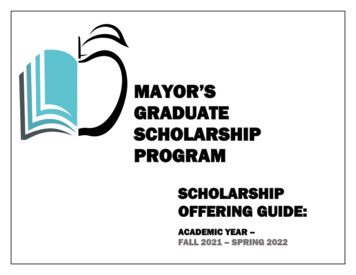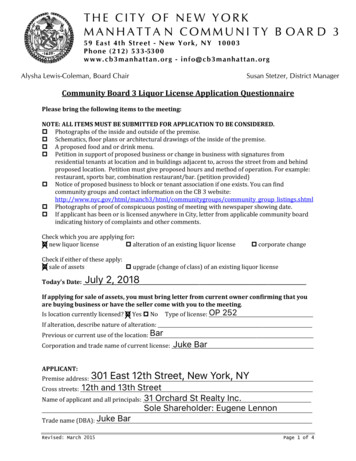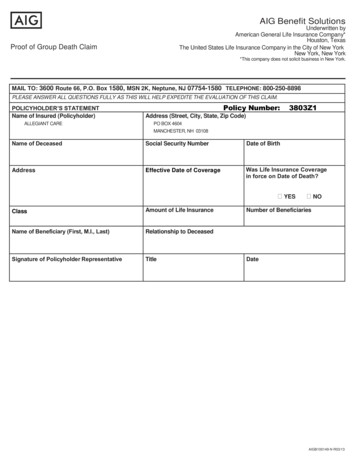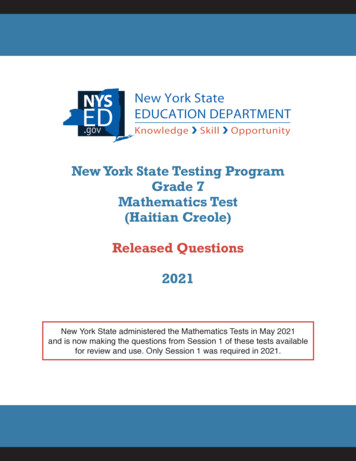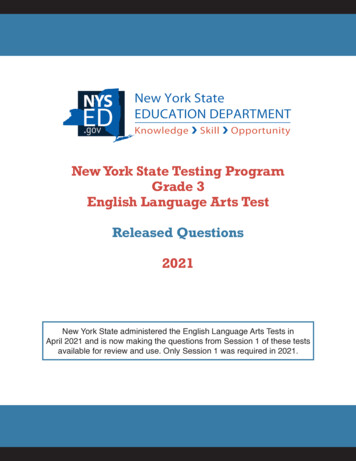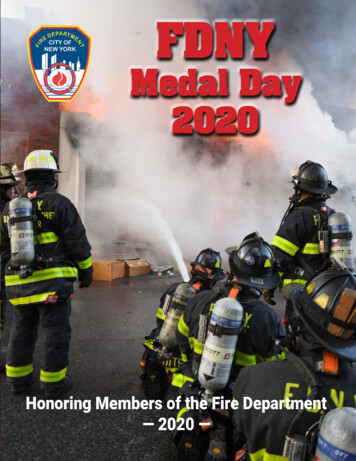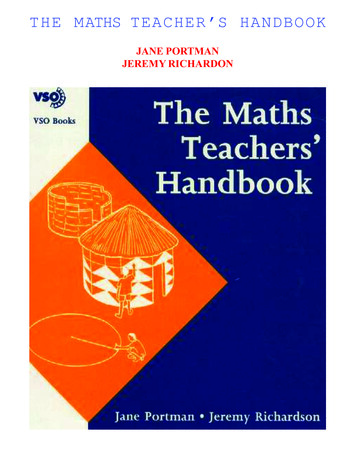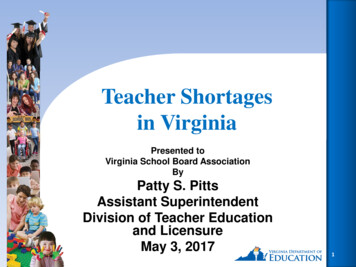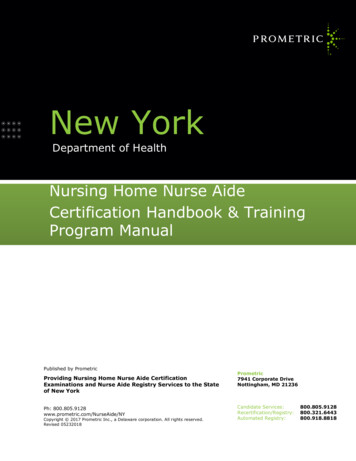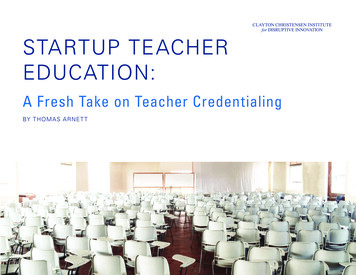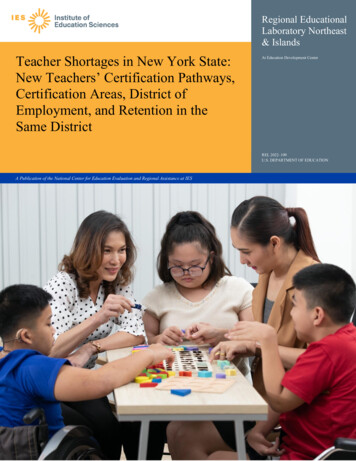
Transcription
Regional EducationalLaboratory Northeast& IslandsTeacher Shortages in New York State:New Teachers’ Certification Pathways,Certification Areas, District ofEmployment, and Retention in theSame DistrictAt Education Development CenterREL 2022–109U.S. DEPARTMENT OF EDUCATIONA Publication of the National Center for Education Evaluation and Regional Assistance at IESREL 2022–109C-0
Teacher Shortages in New York State: New Teachers’Certification Pathways, Certification Areas, District ofEmployment, and Retention in the Same DistrictJacqueline Zweig, Camille Lemieux, Karen Shakman, Laura O’Dwyer, and Rebecca SchillaciNovember 2021New York State is experiencing teacher shortages in specific subject areas. One way to address these shortagesis through the certification and placement of new teachers. This study explored the pathways through whichnew teachers between 2015/16 and 2017/18 earned certificates, their certification areas, and theirsubsequent placement and retention in districts across the state, particularly high-need districts. While themajority of new teachers earned certificates through the traditional in-state pathway, this varied somewhatby certification area. The proportion of teachers who earned certificates through the individual evaluationpathway was higher for the shortage certification area of career and technical education than for othercertification areas. The most frequent certification area was the shortage certification area of specialeducation, while the shortage certification areas of career and technical education and bilingual specialeducation were among the least frequent. New York City district schools employed new teachers who earnedcertificates through the alternative in-state pathway at a higher rate than other types of high-need districts(rural, large city—not New York City, and other urban/suburban) as well as average- and low-need districts.New teachers employed in high-need districts had higher rates of retention in the same district for a secondyear than new teachers employed in average- and low-need districts. Just 5 percent of new teachers in NewYork State were uncertified.Why this study?Across the country, educators and policymakers are concerned about teacher shortages, particularly in hard-tostaff subject areas and school districts (Gais, Backstrom, Malatras, & Park, 2018; U.S. Department of Education,n.d.; Viadero, 2018). Reduced access to fully certified and experienced teachers can negatively impact studentachievement (Cardichon et al., 2020), and high teacher turnover can be costly, given the substantial resourcesthat many districts allocate to new teacher training. New York State has faced geographically widespread andpersistent teacher shortages (shortages in at least two of the state’s three broad geographic reporting locales—New York City Public Schools, the Big Four [Buffalo Public Schools, Rochester City School District, Syracuse CitySchool District, and Yonkers Public Schools], and the rest of the state—in 2015/16, 2016/17, and 2017/18) inseveral subject areas. Those subject areas include bilingual education, bilingual special education, career andtechnical education, English language arts, health education, library mediaFor additionalspecialist, literacy, mathematics, science, and special education (U.S.information—includingDepartment of Education, n.d.).1technical methods,There are several ways to address these shortages, including the certification ofsupporting analyses, andnew teachers and the additional certification of experienced teachers. Toother analyses—access theprovide a picture of the populations of teachers who might fill positions in thesereport appendixes atshortage areas and suggest potential ways to resolve persistent shortages, thehttps://go.usa.gov/xecdM.Regional Educational Laboratory Northeast & Islands, in collaboration with the1The New York State shortage areas that are reported to the U.S. Department of Education for a given school year are typically based ondata from two school years earlier. For example, the 2017/18 shortage areas are based on 2015/16 data. The shortage areas referenced inthis study were reported as 2017/18, 2018/19, and 2019/20 shortage areas on the U.S. Department of Education website and representshortages that occurred in the 2015/16, 2016/17, and 2017/18 school years.REL 2022–1091
New York State Education Department (NYSED), has prepared a report on each of these groups of teachers. Thecurrent report covers new teachers in New York State (those with less than one year of teaching experience inNew York State public schools), and the companion report covers experienced teachers (those with at least oneyear of teaching experience in New York State public schools) who pursued additional certificates (see Lemieux,Zweig, Shakman, O’Dwyer, & Schilacci, 2021).Like many states, New York State encourages qualified people from various education backgrounds to teach byproviding multiple pathways to teacher certification (see box 1 for definitions of key terms). NYSED wants to betterunderstand the certification pathways that new teachers pursue and the areas in which new teachers seekcertification. In particular, NYSED wants to understand the relationships among certification pathways,certification areas, employment in high-need districts, and second- and third-year retention in the same district.NYSED can use this information to consider certification pathways or requirements and in creating or modifyingincentive programs to increase the number of qualified candidates, particularly in shortage subject areas.This study examined the pathways through which new teachers (teachers who began teaching in New York Statein the 2015/16, 2016/17, and 2017/18 school years) earned certificates, the number and percentage of newteachers who earned certificates through each pathway by certification area, the districts in which new teacherswere employed, and the rates at which new teachers were retained in the same district. NYSED was particularlyinterested in patterns in certification pathways of new teachers because of recent changes to the certificationpathways and requirements, including the introduction of new content specialty tests beginning in 2014.Box 1. Key termsCertificate. A credential that authorizes an individual to teach in a given subject and grade level in New York State publicschools. In this report, the term “certificate” refers to both certificates and certificate extensions (see appendix A foradditional information on extensions).1Certification areas. The 18 areas in which teachers in New York State earned certificates (see appendix A for a definition ofteacher). The dataset contained 597 past and current certificate titles, which indicate the subject and grade level the teacheris certified to teach. The certificate titles were combined into 18 broad certification areas related to teaching for the analyses.For any given certification area, there were between 2 and 218 certificate titles. Each teacher can have multiple certificatesin a single certification area as well as in more than one certification area. The study team counted teachers in a certificationarea if they had earned at least one certificate in that area. Throughout the report, the study team categorized certificationareas into the following two types: Shortage certification areas. Ten certification areas that are related to shortage subject areas (referred tothroughout the report as shortage areas) in New York State. NYSED does not report shortages related to certificationareas but rather related to course assignment areas in which full-time equivalent teaching positions (FTEs) in thesubject area are greater than 5 percent of total FTEs in the subject area (New York State Education Department,personal communication, December 30, 2016). Shortage FTEs are filled by teachers who did not possess statecertification for teaching assignments. This study examined certification areas related to shortage areas, and theseare referred to as “shortage certification areas” throughout the report. The 10 shortage certification areas arebilingual education, bilingual special education,2 career and technical education, English language arts, healtheducation, library media specialist, literacy, mathematics, science, and special education. Special education3 includesthe following New York State certification titles: students with disabilities, students with disabilities and contentarea, blind and visually impaired, deaf and hard of hearing, gifted education, severe or multiple disabilities, 4 andspeech and language disabilities. Nonshortage certification areas. Eight certification areas that are related to subject areas that were notexperiencing widespread and persistent shortages. These certification areas were not related to subject areas thatexperienced a shortage in at least two of the three broad geographic reporting locales (New York City Public Schools,the Big Four [Buffalo Public Schools, Rochester City School District, Syracuse City School District, and Yonkers PublicSchools], and the rest of the state) or in all three years studied (2015/16, 2016/17, and 2017/18). The nonshortageREL 2022–1092
certification areas are arts, English to speakers of other languages, language other than English,5 social studies,physical education, childhood education (which spans grades 1–6), early childhood education (which spans birth–grade 2), and other teaching certification areas.6Certification pathways. There are several pathways by which teachers in New York State earn certificates. Each teacher canhave multiple certificates in one or more pathways. The study team included a teacher in a pathway if the teacher had earnedat least one certificate in that pathway. A small number of teachers in the dataset had no certificate; they are not included inany pathway and are included in the results as a separate category. The five pathways are: Traditional in-state pathway. This pathway is for candidates who complete a New York State-registered teacherpreparation program that includes college-supervised clinical experience(s) during which the candidate is under thedirect supervision of a certified teacher who has official responsibility for the classroom. Only New York Stateinstitutions of higher education are authorized to offer registered teacher preparation programs. Alternative in-state pathway. This pathway is for candidates who are enrolled in a New York State-registeredalternative teacher preparation program. While completing the program, candidates apply for and earn aTransitional B or C teaching certificate and complete a college-supervised placement as a teacher of record in apartnering school. Partnering schools agree to mentor, support, and employ the candidates throughout theirprogram. In this study, all new teachers who were enrolled in this pathway were identified as certified, as they areconsidered certified by New York State. Out-of-state program pathway. This pathway is available for candidates who complete a teacher preparationprogram in another U.S. state or territory that is substantially equivalent to a New York State-registered teacherpreparation program and leads to certification in the title of the New York State certificate sought in the jurisdictionin which the institution of higher education is located (New York State Education Department, n.d.a).7 Individual evaluation pathway. This pathway is available for candidates who do not meet the requirements for thetraditional in-state, alternative in-state, and out-of-state program pathways. They can apply for certification throughthis pathway by providing transcripts or, in the case of career and technical education certificates, evidence of prioreducation, credentials, and/or work experience. NYSED’s level of effort to review certificate applications in thispathway is higher than in other pathways (New York State Education Department, personal communication,September 1, 2020; see appendix A for more information).8 Certificate progression pathway. This pathway is for teachers who hold or held a valid New York State entry-levelcertificate and seek to progress to an advanced-level certificate (New York State Education Department, n.d.a).Need designation. A measure of a district’s ability to meet the needs of its students with local resources. 9 NYSED calculatedthis measure by dividing a district’s estimated poverty percentage by its Combined Wealth Ratio. 10 The Combined WealthRatio was a measure of a district’s fiscal capacity and was based equally on property wealth per pupil and income wealth perpupil compared to the statewide average. (See appendix A for details.)There are six need designations. The high-need designations are New York City district schools, large city—not New York City,urban/suburban, and rural. The two other designations are average need and low need (New York State EducationDepartment, n.d.b). Each district was assigned only one need designation. Teachers may teach in more than one district atthe same time, each with a different need designation. Need designation data are reported at the district level, with theexception of teachers employed in charter schools. Charter schools are not included in the need designations in New YorkState, but for completeness they are included as a separate category.New teacher in New York State. A prekindergarten–grade 12 classroom teacher, educational technology specialist, librarymedia specialist, or literacy specialist with less than one year of experience teaching in New York State public schools.11Administrators, pupil personnel service professionals such as school psychologists and school social workers, andsupplemental school personnel such as teacher aides and teaching assistants are not included in this definition.Retention in the same district. The percentage of teachers who were retained, or the rate of retention, in the same districtfor a second year or a third year. NYSED was interested in retention at the district level rather than the state level because ofthe substantial resources that districts invest in new teachers. New teachers who left teaching but stayed in the same districtin a nonteaching role in a subsequent year were treated as not retained in the calculations for this study. Charter schoolsREL 2022–1093
were excluded from the retention analysis because the unit of analysis differs between charter schools (school) and the otherneed designation categories (district).Notes1. There is one annotation: severe or multiple disabilities. An annotation is a type of certificate that is not freestanding and is always attached to a basecertificate. The annotation alone does not authorize an individual to teach in the particular subject area but indicates expertise in the defined area. Noteachers in the sample received the annotation without earning a specified special education certificate as well.2. There is not a bilingual special education certificate, but bilingual special education is a shortage area. In this study teachers were counted as havingearned a certificate in bilingual special education if they had at least one certificate in bilingual education and at least one certificate in special education(excluding gifted education because the shortage area of bilingual special education does not pertain to those with teaching assignments related to giftededucation).3. Special education includes certificates in multiple special education subject areas, some of which NYSED does not report to the U.S. Department ofEducation in this specificity when computing data on shortages. The special education shortage area is based on courses taught by teachers who hold SpecialEducation or Students with Disabilities certificate titles, rather than specialized certificates in the area of special education, such as Blind and VisuallyImpaired and Deaf and Hard of Hearing.4. Severe or multiple disabilities is an annotation.5. NYSED recently changed “language other than English” to “world language other than English.” However, because this report references historical data,it retains the older terminology.6. The study team used the same certification areas in this report and in the companion report on experienced teachers, with the exception of theadministration certification area, which is omitted in this report. Very few new teachers seek an administration certificate with their first teaching certificate,whereas it is much more common among experienced teachers to earn an administration certificate as an additional certificate.7. There is another out-of-state pathway for candidates who have at least three years of acceptable teaching experience in public schools in another U.S .state or territory within the past seven years and hold a valid certificate in that state or territory that is equivalent to the title of the New York State certificatesought. These candidates were not included in this study because they are not considered new teachers.8. When reviewing the certificate application, NYSED staff evaluate each requirement individually, including coursework listed on transcripts. Teachers canuse this pathway when they have completed acceptable coursework over time at various institutions in and out of state or when they are ineligible for otherpathways (New York State Education Department, personal communication, September 1, 2020).9. New York State refers to this measure as “need/resource capacity” because it measures need relative to resources.10. The Combined Wealth Ratio was calculated as follows: (0.5 the pupil wealth ratio) (0.5 the alternate pupil wealth ratio). The Pupil Wealth Ratioequaled the actual value of property in 1995 divided by a weighted pupil count. The Alternate Pupil Wealth Ratio equaled the district’s 1994 adjusted grossincome divided by a weighted pupil count. The weighted pupil count was based on the adjusted average daily attendance of K–12 students in the districtplus weightings for students with special education needs, students with disabilities, and secondary school students; half-day kindergarten students wereweighted at 0.5.11. The total years of teaching variable in the Basic Education Data System Personnel Master File data determined teachers’ experience in New York State.NYSED defined the roles that are considered a teacher. A REL Northeast & Islands companion report (see Lemieux et al., 2021) examines certificationpathways and certification areas for experienced teachers in New York State. This study uses a snapshot of teacher data from the first Wednesday in Octobereach year (New York State Education Department, 2019).Research questionsThe study team addressed the following questions about public school teachers with less than one year ofexperience teaching in New York State in 2015/16, 2016/17, and 2017/18:1. Through which certification pathways did they earn their first certificates?2. In which certification areas did they earn their first certificates?a. By certification area, which pathways did they use?3. What is their district of employment’s need designation and what, if any, relationships exist amongcertification pathways, certification areas, and district need designation?4. To what extent were they retained in the district, and what were the certification pathways andcertification areas of those who were retained?22New teachers employed by charter schools were not included in the analysis for research question 4 because it focused on retention atthe district level.REL 2022–1094
Box 2 summarizes the data sources, sample, methodology, and limitations, and appendix A provides additionalinformation.Box 2. Data sources, sample, methodology, and limitationsData sources. The study used data from the New York State Education Department’s (NYSED’s) TEACH system and BasicEducation Data System Personnel Master File. The TEACH system is the platform through which individuals apply forcertification. It maintains data on all certificate holders, including certificate titles, certificate issue dates, and certificationpathways. The Basic Education Data System Personnel Master File contains annual data on teachers, such as the number ofyears of teaching experience in New York State, school and district assignments, region, and district need designation (seetable A2 in appendix A for a list of data elements and their sources). Each teacher has a unique identification number thatlinks them in the TEACH system and the Basic Education Data System Personnel Master File.Sample. The sample consisted of 22,424 unique new teachers in New York State from three school years: 2015/16, 2016/17,and 2017/18. Individuals with more than one role were considered a teacher if they had at least one teaching role. Acrossthe sample, 1,173 teachers were uncertified—that is, they taught in New York State public schools, including a charter school,but did not hold a valid certificate documented in the TEACH system. Teachers could earn multiple certificates, for examplein different certification areas or grade levels (see table A3 in appendix A for the number of certificates in each certificationarea). The study team counted teachers one time for each certification area in which they earned at least one certificate.Uncertified teachers were counted one time. Certificates could be earned through different pathways, though a teacher coulduse only one pathway per certificate. Additionally, region and need designation data were missing for 3 percent of the sample.Teachers with missing region and need designation data remained in the sample, so their certification pathway andcertification areas were included. For these reasons the numbers in figures and tables throughout the report do not sum tothe 22,424 unique teachers in the sample, nor do the percentages sum to 100 (see the notes in figures and tables for furtherexplanation). Because of these variations in the number of certificates earned, pathways used, and districts in which teachersin the sample were employed, each research question had a different sample size (see table A4 in appendix A for a descriptionof each sample).Methodology. The study team calculated the number and percentage of new teachers in New York State who earnedcertificates through each certification pathway. Certificates that were expired, revoked, surrendered, or suspended were notincluded in the analyses. Each certification pathway was calculated as a binary variable—yes or no—for each type of pathwayregardless of how many certificates a teacher earned through that pathway. Teachers could earn certificates through morethan one pathway and in more than one certification area. For example, a teacher who earned one certificate through thetraditional in-state pathway and two certificates through the individual evaluation pathway received a 1 for the traditionalin-state pathway variable, a 1 for the individual evaluation pathway variable, and a 0 for each other pathway variable.The study team calculated the number and the percentage of new teachers who: Earned at least one certificate through each certification pathway (research question 1). Earned at least one certificate in a certification area by certification area (research question 2) and in eachcertification area by pathway (research question 2a). Were employed in districts with each need designation (research question 3). Were retained in the same district for a second year and a third year (research question 4).The study team also analyzed the above characteristics by certification pathway. The analysis of retention in the same districtincluded only new teachers from the 2015/16 and 2016/17 school years because at the time of the study no data wereavailable to calculate third-year retention rates for new teachers from the 2017/18 school year. Teachers employed in charterschools were also excluded from the retention analysis (see appendix A).The report highlights differences of more than 5 percentage points as substantive (see appendix A).Limitations. A primary limitation of this study is that it was not possible to distinguish novice teachers whose first teachingjob was in New York State from teachers who had experience teaching out of state and had a new teaching job in New YorkState. The Basic Education Data System questionnaire asks about teaching experience only in New York State, so someREL 2022–1095
teachers designated as “new” might have been new to teaching in New York State but not new to the teaching profession.Had these two groups been analyzed separately, different results might have been observed. In addition, the “new teacherin New York State” designation is based on a teacher-reported measure and could include errors.Although data allowed teacher placement to be examined by district, the data for this study did not include teachers’ specificcourse assignments. As a result, the study could not analyze the extent to which new teachers taught in their certificationarea. Shortages might be higher than the findings suggest if many teachers with certificates in a shortage area could not easilybe placed in that area. For example, a teacher might earn certificates related to two shortage areas but can teach in only oneof them, or a teacher might prefer to not teach in a shortage area despite having earned a certificate related to that area.This report, therefore, documents the pool of teachers with certificates related to shortage areas—not whether they wereactually assigned to courses in those areas. This study and its companion study provide New York State with a morecomprehensive picture of the potential pool of candidates to address the shortages. Additional research is needed tounderstand the match between the number of new teachers earning certificates in areas related to shortage areas and thenumber of full-time equivalents or positions available in those areas.This descriptive study cannot support causal inferences about the relationships among certification pathways, certificationareas, and employment location.FindingsThe findings in this section address the research questions in order. The first finding relates to research question 1on the pathways through which new teachers earned certificates. The second and third findings address researchquestion 2 on the certification areas of new teachers, with particular focus on the shortage areas as well as on thepathways through which teachers earned certificates in each certification area. The remaining findings relate toresearch questions 3 and 4 and examine placement by need designation; retention in the same district; andpatterns among certification pathway, certification area, and retention.The majority of new teachers earned certificates through the traditional in-state pathwayAbout 73 percent of new teachers earned certificates through the traditional in-state pathway, and 23 percentdid so through the individual evaluation pathway (table 1). The alternative in-state pathway (15 percent) and outof-state program pathway (7 percent) were used less frequently. The percentages of new teachers who used thesefour certification pathways were substantively different. A small percentage of teachers (2 percent) earnedcertificates through the certificate progression pathway. These teachers are included in all the analyses becausethe data included all new teachers in New York State without distinguishing between those who were new to theteaching profession and those who had teaching experience in another state. Because this report focuses on thecertification pathways of teachers new to the profession of teaching, this pathway is not discussed elsewhere.About 5 percent of new teachers were uncertified. Teachers can earn multiple certificates through multiplepathways, so the sum of these percentages exceeds 100.REL 2022–1096
Table 1. Number and percentage of new teachers who earned certificates through each pathway in New YorkState, 2015/16–2017/18Certification pathwayTraditional in-state pathwayNumber of new teachersPercent of new teachers16,28073Individual evaluation pathway5,13023Alternative in-state pathway3,31315Out-of-state program pathway1,492752521,1735Certificate progression pathwayUncertified teachersNote: The sample consisted of 22,424 unique new teachers in New York State in 2015/16–2017/18. The sum of the values in the second column is 27,913and the sum of the values in the third column exceeds 100 because some teachers earned multiple certificates through multiple pathways (16,070 earnedcertificates through one pathway, 4,752 earned certificates through two pathways, 378 earned certificates through three pathways, and 8 earned certificatesthrough four pathways). In addition, the table excludes 43 new teachers who earned certificates in nonteaching areas but had teaching assignments between2015/16 and 2017/18.Source: Authors’ analyses of 2015–18 data from the New York State Education Department’s TEACH system.The most frequent certification area for new teachers was the shortage certification area of specialeducation, while the shortage certification areas of career and technical education and bilingualspecial education were among the least frequentNew teachers earned certificates most frequently in the shortage certification area of special education (40percent, which was substantively higher than all other shortage certification areas; table 2; see also table B2 inappendix B). In contrast, new teachers earned certificates least frequently in the shortage certification areas ofcareer and technical education, bilingual special education, and library media specialist (1 percent each). Innonshortage certification areas new teachers earned certificates most frequently in childhood education (38percent) and early childhood education (17 percent). 3 About 1–8 percent of new teachers earned certificates ineach of the remaining shortage and nonshortage certification areas. About 44 percent of new te
The study team counted teachers in a certification area if they had earned at least one certificate in that area. Throughout the report, the study team categorized certification areas into the following two types: Shortage certification areas. Ten certification area
